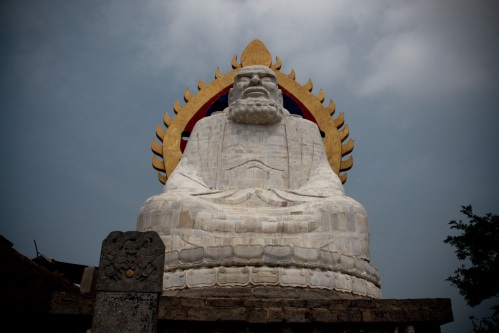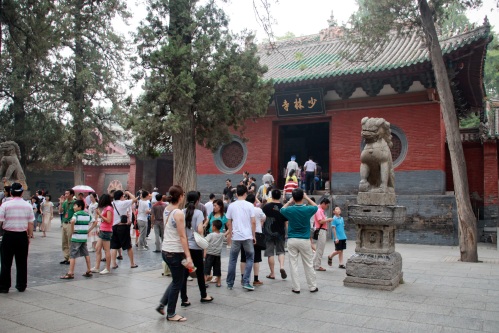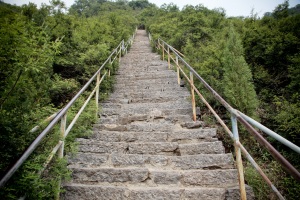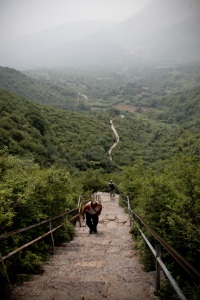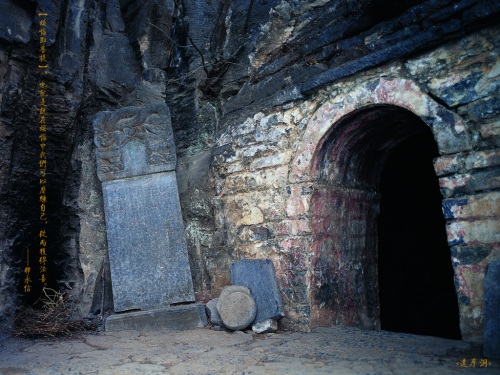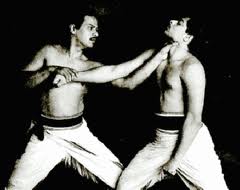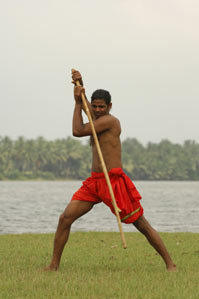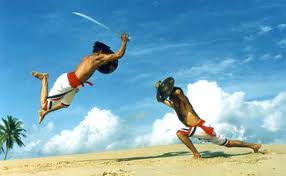Bodhi Dharma also known as, Da Mo, Bodhitara, P’u-t’i Ta-mo, Ta-mo, Bodai Daruma, and Daruma was born in Kanchi in the Southern Indian kingdom (today’s Tamil Nadu State ) of Pallava around year 440. Bodhi Dharma was the youngest of three brothers in the royal family of the southern Indian kingdom of Pallava king Sugandan. His father, the king Sugandan,
also known as Simhavarman was a devoted Buddhist and managed state
affairs according to the Buddha’s teachings. At birth Bodhi Dharma was
born with a breathing disorder. He was adopted and trained at
birth in breathing exercises and combat, namely in the arts of Dravidian
warfare arts of Southern India and self-defense techniques
such Kuttu Varisai and Pidi Varesai (Punches Series- hand to hand combat
with animal styles and locking techniques Similar to Kung Fu and
Karate), Malyutham (grappling), Varma Kalai (Secret or Vital Art,
Pressure point attacks, In healing and Self-defense similar to Tai Chi
or Dim Mak), Silambam (staff fighting), Eretthai or Saydekuche (double
stick fighting), Madhu or Madi (deer horn weapon fighting), Surul Pattai
or Surul wall (steel blade whip), Val Vitchi (single sword), and
Eretthai Val (double short sword) fighting. Bodhidarma also studied Dhyana Buddhism and became the 28th patriarch of that religion.
Brief Story:
Shaolin monks and disciples follow a unique practice among Buddhists in that they greet each other using only their right hand. This greeting is a tradition which dates back to Bodhidharma and his disciple, Hui Ke.In 495 AD, the Indian monk Ba Tuo, or Buddhabhadra, came to China teaching a form of Buddhism known as Xiao Sheng Buddhism. He was given land at the foot of Shaoshi mountain by Emperor Shao Wen and founded the Shaolin Temple on this land.
Around the time that Ba Tuo was founding the Shaolin Temple there was an Indian prince named Bodhidharma. Bodhidharma was very intelligent and was the favorite son of the king of India. Bodhidharma had two older brothers who feared that their father, the king, would pass them over and bequeath the kingship to Bodhidharma. In their jealousy, the two older brothers often disparaged Bodhidharma while talking with their father, hoping to turn him against their younger brother. The older brothers also attempted to assassinate Bodhidharma but Bodhidharma had very good karma and so the attempts were not successful. Despite being the favorite son of the king, Bodhidharma realized that he was not interested in a life of politics. He chose instead to study with the famous Buddhist master Prajnatara and become a Buddhist monk.
Bodhidharma trained with his master for many years. One day he asked his master, “Master, when you pass away, where should I go? What should I do?” His master replied that he should go to Zhen Dan, which was the name for China at that time. Years later, Bodhidharma’s master passed away and Bodhidharma prepared to leave for China.
During the many years that Bodhidharma had studied as a monk, one of his older brothers had become king of India and that older brother’s son had become king after him. The king of India was very fond of his uncle and wanted to make amends for the actions which Bodhidharma’s older brothers had taken against him. He asked Bodhidharma to stay near the capital, where he could protect and care for him, but Bodhidharma knew that he must go to China as his master had said.
Seeing that Bodhidharma would not remain, the king of India ordered that carrier pigeons be sent to China with messages asking the people of China to take care of Bodhidharma. These messages made Bodhidharma famous among many Chinese who wondered what was so special about this particular Buddhist monk that the king of India would make such a request.
“According to Southeast Asian folklore, Bodhidharma travelled from south India by sea to Sumatra, Indonesia for the purpose of spreading the Mahayana doctrine. From Palembang, he went north into what are now Malaysia and Thailand. He travelled the region transmitting his knowledge of Buddhism and martial arts before eventually entering China through Vietnam. Malay legend holds that Bodhidharma introduced preset forms to silat.“In 527 AD, 32 years after Ba Tuo’s founding of the Shaolin temple, Bodhidharma crossed through Guangdong province into China. In China, he was known as Da Mo. Bodhidharma arrived in China practicing Da Sheng (Mahayana) Buddhism. When Bodhidharma arrived, he was greeted by a large crowd of people who had heard of the famous Buddhist master and wished to hear him speak. Rather than speak, Bodhidharma sat down and began meditating. He meditated for many hours. Upon completing his meditation, Bodhidharma rose and walked away, saying nothing.
His actions had a profound effect upon his audience. Some people laughed, some cried, some were angry and some nodded their heads in understanding. Regardless of the emotion, everyone in the crowd had a reaction.
This incident made Bodhidharma even more famous, so famous that Emperor Wu heard of him. Emperor Wu, who ruled over the southern kingdom of China, invited Bodhidharma to come to his palace. When Bodhidharma arrived, Emperor Wu talked with Bodhidharma about Buddhism. The emperor had erected many statues and temples devoted to Buddhism. He had given much wealth to Buddhist temples. In talking of his accomplishments, Emperor Wu asked Bodhidharma if his actions were good. Bodhidharma replied that they were not. This response surprised Emperor Wu, but they continued talking and eventually Emperor Wu asked Bodhidharma if there was Buddha in this world. Bodhidharma replied that there was not.
Bodhidharma’s replies were a reflection of Emperor Wu. By asking if his actions were good, Emperor Wu was searching for compliments and affirmation from Bodhidharma. Bodhidharma denied that Emperor Wu’s actions were good because it is the duty of the emperor to care for his people. Rather than seeking compliments, Emperor Wu should have been content to help his people through Buddha. Similarly, if one asks if there is Buddha in the world, then one has already answered the question: Buddha is a matter of faith, you either believe in your heart or you do not. In questioning the existence of Buddha, Emperor Wu had demonstrated a lack of faith.
Bodhidharma’s answers enraged Emperor Wu and he ordered Bodhidharma to leave his palace and never return. Bodhidharma simply smiled, turned and left.
Bodhidharma continued his journey, heading north, when he reached the city of Nanjing. In the city of Nanjing, there was a famous place called the Flower Rain Pavillion where many people gathered to speak and relax. There was a large crowd of people gathered in the Flower Rain Pavillion around a Buddhist monk, who was lecturing. This Buddhist monk was named Shen Guang.
Shen Guang had at one time been a famous general. He had killed many people in battle but one day realized that the people he had been killing had family and friends and that one day someone might come and kill him. This changed him and he decided to train as a Buddhist monk. Eventually, Shen Guang became a great speaker on Buddhism. As Bodhidharma neared the crowd, he listened to Shen Guang’s speech. Sometimes Shen Guang would speak and Bodhidharma would nod his head, as if in agreement. Sometimes Shen Guang would speak and Bodhidharma would shake his head, as if in disagreement. As this continued, Shen Guang became very angry at the strange foreign monk who dared to disagree with him in front of this crowd. In anger, Shen Guang took the Buddhist beads from around his neck and flicked them at Bodhidharma. The beads struck Bodhidharma in his face, knocking out two of his front teeth. Bodhidharma immediately began bleeding. Shen Guang expected a confrontation; instead, Bodhidharma smiled, turned and walked away.
This reaction astounded Shen Guang, who began following after Bodhidharma.
Bodhidharma continued north until he reached the Yangzi river. Seated by the river there was an old woman with a large bundle of reeds next to her. Bodhidharma walked up to the old woman and asked her if he might have a reed. She replied that he might. Bodhidharma took a single reed, placed it upon the surface of the Yangzi river and stepped onto the reed. He was carried across the Yangzi river by the force of his chi. Seeing this, Shen Guang ran up to where the old woman sat and grabbed a handful of reeds without asking. He threw the reeds onto the Yangzi river and stepped onto them. The reeds sank beneath him and Shen Guang began drowning. The old woman saw his plight and took pity on Shen Guang, pulling him from the river. As Shen Guang lay on the ground coughing up river water, the old woman admonished him. She said that by not asking for her reeds before taking them, he had shown her disrespect and that by disrespecting her, Shen Guang had disrespected himself. The old woman also told Shen Guang that he had been searching for a master and that Bodhidharma, the man he was following, was that master. As she said this, the reeds which had sunk beneath Shen Guang rose again to the surface of the river and Shen Guang found himself on the reeds being carried across the Yangzi river. He reached the other side and continued following after Bodhidharma.
There are many people who believe that the old woman by the river was a Boddhisatva who was helping Shen Guang to end the cycle of his samsara.
At this point, Bodhidharma was nearing the location of the Shaolin Temple. The Shaolin monks had heard of his approach and were gathered to meet him. When Bodhidharma arrived, the Shaolin monks greeted him and invited him to come stay at the temple. Bodhidharma did not reply but he went to a cave on a mountain behind the Shaolin Temple, sat down, and began meditating. In front of the Shaolin Temple, there are five mountains: Bell Mountain, Drum Mountain, Sword Mountain, Stamp Mountain and Flag Mountain. These mountains are named after the objects which their shape resembles. Behind the Shaolin Temple there are five “Breast Mountains” which are shaped like breasts. The cave in which Bodhidharma chose to meditate was on one of the Breast Mountains.
Bodhidharma sat facing a wall in the cave and meditated for nine years. During these nine years, Shen Guang stayed outside Bodhidharma’s cave and acted as a bodyguard for Bodhidharma, ensuring that no harm came to Bodhidharma. Periodically Shen Guang would ask Bodhidharma to teach him, but Bodhidharma never responded to Shen Guang’s requests. During these nine years the Shaolin monks would also periodically invite Bodhidharma to come down to the Temple, where he would be much more comfortable, but Bodhidharma never responded. After some time, Bodhidharma’s concentration became so intense that his image was engraved into the stone of the wall before him.
Towards the end of the nine years, the Shaolin monks decided that they must do something more for Bodhidharma and so they made a special room for him. They called this room the Bodhidharma Ting. When this room was completed at the end of the nine years, the Shaolin monks invited Bodhidharma to come stay in the room. Bodhidharma did not respond but he stood up, walked down to the room, sat down, and immediately began meditating. Shen Guang followed Bodhidharma to the Shaolin temple and stood guard outside Bodhidharma’s room. Bodhidharma meditated in his room for another four years. Shen Guang would occasionally ask Bodhidharma to teach him, but Bodhidharma never responded.
At the end of the four-year period Shen Guang had been following Bodhidharma for thirteen years, but Bodhidharma had never said anything to Shen Guang. It was winter when the four-year period was ending and Shen Guang was standing in the snow outside the window to Bodhidharma’s room. He was cold and became very angry. He picked up a large block of snow and ice and hurled it into Bodhidharma’s room. The snow and ice made a loud noise as it broke inside Bodhidharma’s room. This noise awoke Bodhidharma from his meditation and he looked at Shen Guang. In anger and frustration Shen Guang demanded to know when Bodhidharma would teach him.
Bodhidharma responded that he would teach Shen Guang when red snow fell from the sky.
Hearing this, something inside Shen Guang’s heart changed and he took the sword he carried from his belt and cut off his left arm. He held the severed arm above his head and whirled it around. The blood from the arm froze in the cold air and fell like red snow. Seeing this, Bodhidharma agreed to teach Shen Guang.
Bodhidharma took a monk’s spade and went with Shen Guang to the Drum Mountain in front of Shaolin Temple. The Drum Mountain is so called because it is very flat on top. Bodhidharma’s unspoken message to Shen Guang was that Shen Guang should flatten his heart, just like the surface of the Drum Mountain. On this Drum Mountain Bodhidharma dug a well. The water of this well was bitter. Bodhidharma then left Shen Guang on the Drum Mountain. For an entire year, Shen Guang used the bitter water of the well to take care of all of his needs. He used it to cook, to clean, to bathe, to do everything. At the end of the first year, Shen Guang went down to Bodhidharma and again asked Bodhidharma to teach him. Bodhidharma returned with Shen Guang to the Drum Mountain and dug a second well. The water of this well was spicy. For an entire year, Shen Guang used the spicy water for all of his needs. At the end of the second year, Shen Guang went back down to Bodhidharma and asked again to be taught. Bodhidharma dug a third well on the Drum Mountain. The water of this third well was sour. For the third year, Shen Guang used the sour water for all of his needs. At the end of the third year, Shen Guang returned to Bodhidharma and agains asked to be taught. Bodhidharma returned to the Drum Mountain and dug a fourth and final well. The water of this well was sweet. At this point, Shen Guang realized that the four wells represented his life. Like the wells, his life would sometimes be bitter, sometimes sour, sometimes spicy and sometimes sweet. Each of these phases in his life was equally beautiful and necessary, just as each of the four seasons of the year is beautiful and necessary in its own way. Without really saying many words to Shen Guang, Bodhidharma had taught Shen Guang the most important of lessons in a mind-to-mind, heart-to-heart fashion. This mind-to- mind, heart-to-heart communication is called “action language” and is the foundation of the Chan Buddhism which Bodhidharma began at the Shaolin Temple.
After his realization, Shen Guang was given the name Hui Ke and he became abbot of the Shaolin temple after Bodhidharma.
To pay respect for the sacrifice which Hui Ke made, disciples and monks of the Shaolin Temple greet each other using only their right hand.
Legend of Bodhidharma
“According to the Jingde of the Lamp, after Bodhidharma, a Buddhist monk from South India, left the court of the Liang emperor Wu in 527, he eventually found himself at the Shaolin Monastery, where he “faced a wall for nine years, not speaking for the entire time”.”
According to the Yì Jīn Jīng,
“after Bodhidharma faced the wall for nine years at Shaolin temple and made a hole with his stare, he left behind an iron chest. When the monks opened this chest they found two books: the “Marrow Cleansing Classic,” and the “Muscle Tendon Change Classic”, or “Yi Jin Jing” within. The first book was taken by Bodhidharma’s disciple Huike, and disappeared; as for the second, the monks selfishly coveted it, practicing the skills therein, falling into heterodox ways, and losing the correct purpose of cultivating the Real. The Shaolin monks have made some fame for themselves through their fighting skill; this is all due to their possession of this manuscript.”
Influence outside China
Some lineages of Karate have oral traditions that claim Shaolin origins. Martial arts traditions in Japan and Korea, and Southeast Asia cite Chinese influence as transmitted by Buddhist monks.Recent developments in the 20th century such as Shorinji Kempo practised in Japan’s Sohonzan Shorinji still maintains close ties with China’s Song Shan Shaolin Temple due to historic links. Japanese Shorinji Kempo Group financial contributions to the maintenance of the historic edifice of the Song Shan Shaolin Temple in 2003 received China’s recognition.
After death
Three years after Bodhidharma’s death, Ambassador Song Yun of northern Wei is said to have seen him walking while holding a shoe at the Pamir Heights. Song Yun asked Bodhidharma where he was going, to which Bodhidharma replied “I am going home”. When asked why he was holding his shoe, Bodhidharma answered “You will know when you reach Shaolin monastery. Don’t mention that you saw me or you will meet with disaster”. After arriving at the palace, Song Yun told the emperor that he met Bodhidharma on the way. The emperor said Bodhidharma was already dead and buried, and had Song Yun arrested for lying. At the Shaolin Temple, the monks informed them that Bodhidharma was dead and had been buried in a hill behind the temple. The grave was exhumed and was found to contain a single shoe. The monks then said “Master has gone back home” and prostrated three times.For nine years he had remained and nobody knew him;
Carrying a shoe in hand he went home quietly, without ceremony
South Indian Martial Art Pic
http://www.silambam.in/silambam.htm
http://vazhipokkanpayanangal.blogspot.com/2011/10/5.html
http://www.waltsdorsai.net/damo.htm
http://www.butthan.net/history.html Related Chines Movi(Total 11 Parts): Bodhidharma – The Master of Zen http://www.youtube.com/watch?v=VsFA7aTRISM http://www.youtube.com/watch?v=4p0gvd1Lqto&feature=related
